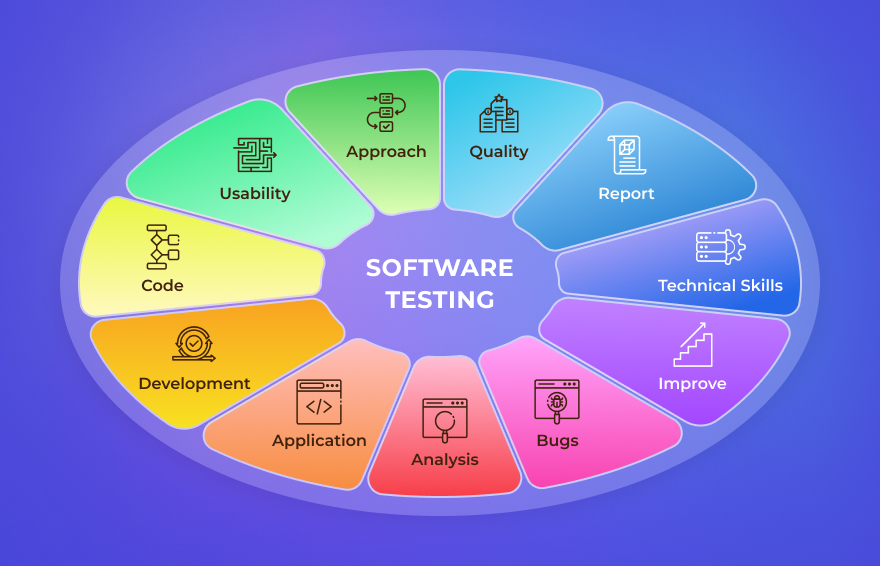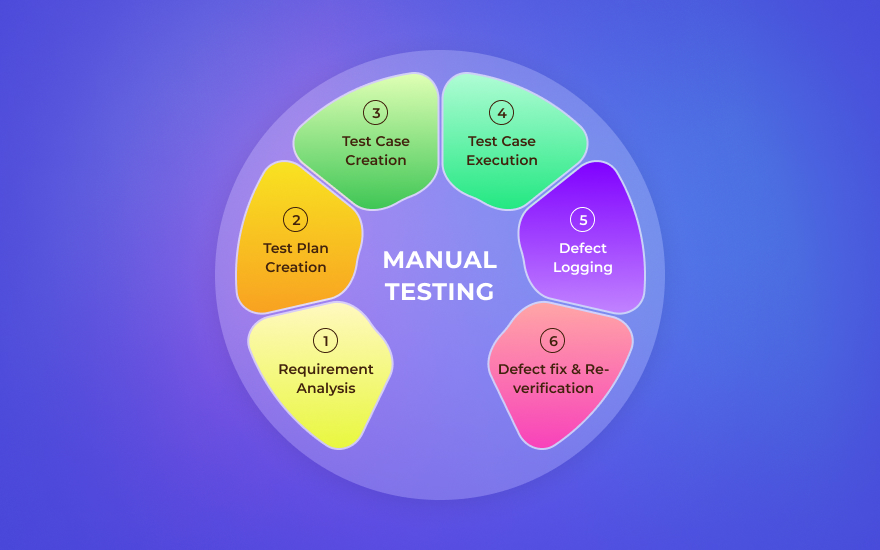Table of Contents
The last decade has seen a massive shift toward automated testing practices, which wiped out the manual handling of a lot of rote tasks. Not a day goes by that we don’t hear someone say automation will eliminate manual testing jobs – or that unit testing, integration testing, and user acceptance testing are becoming inconsequential in today’s digital environments. But this is not true, of course.
As we know, there are two main approaches to software testing – manual testing and automated testing. In manual testing, as the name suggests, all checks are done manually. Automated – test automation engineers write codes in advance, and then the tests are executed by computers automatically.
Over the past few years, automated testing has become increasingly popular. And this is not at all surprising. It really has a lot of advantages. Automated testing takes less time in comparison with manual testing concepts. You can quickly run many repetitive tests that would take many hours of work if done by manual tests. It also allows you to achieve greater test coverage. And in the long run, it is often more cost-effective.
It is not surprising that all this causes a lively discussion about the importance and necessity of manual testing. Sometimes you can hear that companies do not need manual testing team at all anymore. But this, of course, is not the case. For many software projects, manual testing is the only way to create the highest quality product possible.
In this article, we want to burst people’s bubble about the future of manual testing with a few facts. In the future, we can expect that robotic process automation, machine learning, and AI will increasingly complement manual expertise. Automation, however, will never act as a total proxy for manual practices because no robot is a substitute for human inspection. There are many reasons why we cannot rely solely on automated tests. Let’s talk about the most important of them.

The essence of testing on software project
Before we will dive in duties and role of manual software testing and its differentiators and benefits over the automation testing, we would like to start without lining the importance of the software testing life cycle in software development process in general.
Despite testing stage of the software development is supposed to be final before the software product launch and the solution is already built, testing still remains the crucial part of software development process. For instance, in Altamira we perform manual testing and automation testing on each development sprint which stands for a certain part of functionality.
However, the testing the complete software products is also obvious to ensure the different parts of functionality works correctly altogether. For execution of this process, we use manual testing as well as automation testing, depending on the specifics of the developed software system.
Further, we are going to emphasize the benefits and applications of manual software testing on various projects, however, manual testing cannot be compared to the automated tests, as these types of software testing are independent ways to examine the solution.
The role and advantages of manual testing
Manual testing is cheaper for many software projects
Automated testing tools are expensive. In addition, they cannot work without a person, and the salary of experienced test automation engineers is quite high. Therefore, for many projects, the cost of manual testing can be unreasonably high. The manual approach allows the company to conduct the necessary tests without significant initial investment.
Humans are incomparably better at understanding other humans than machines are
Manual testing team outstrips any algorithm when it comes to uncovering user motivations, especially bite-sized behavioral insights that reveal why certain functions are performing and others aren’t. From a bottom-line perspective, humans can shine an immediate spotlight on what processes customers need and what operations they care about. They can recognize what paths they’re drawn to or what they ignore, and they can identify at what juncture they get stuck and overwhelmed and when they give up.
Manual testing makes it easier to test small changes
One of the main reasons why automated software testing is so popular is because it helps reduce the time it takes to develop new software. With the help of automation testing tools, software tester can execute a huge number of tests in a very short time. And this, of course, is true. But here’s the thing.
Test automation engineers need time to plan and code. And every time they make changes to the software, they have to change their test codes as well. And again, this takes time. Thus, when dealing with frequently repeated changes, manual testing is more effective.

Manual testing helps evaluate how the user will perceive the product
Even the biggest fans of automated software testing cannot ignore this. The human eyes and brain are indispensable in user experience testing. Yes, we can check element placement and alignment with automated tests. But, as a rule, when developing a new product, a deeper assessment is required.
Is this particular interface user-friendly? How visually appealing is this app? Is the new video game exciting? No automation tool can answer these questions, unlike manual testing tools.
Automated tools can’t evaluate the aesthetic components of software application
Cosmetic factors, such as color, font, size, contrast, or button length, can’t be successfully gauged by an algorithm. Only a human can determine whether the red color – crimson, scarlet, ruby, or a specific gradient of burgundy – is the one that matches client parameters.
Also, relying on automated test suites to determine if element positioning on a page looks the same across all mobile devices, browsers and operating systems won’t work. Some automated scripts require tests based on the X and Y coordinates of elements, and those change depending on screen size.
Automated software testing type can only test what is predictable
With automated testing, we can make sure that what we expect actually happens. That is, automatic tests can evaluate only what is written in advance. They are unable to check the unforeseen.
But even the most experienced test engineers cannot always predict exactly how users will interact with the software application. Exploratory software testing process comes to the rescue, where manual testers go beyond strictly prescribed test scripts. They strive to be creative in studying software and find bugs that no one could have imagined.
Pass-fail checking performed by automated tools can get flaky
As soon as automated scripts are up and running, many managers start to put their feet up. They get a false sense of assurance that the pass-fail outcomes are sufficient and slumber when it comes to exhaustive analyses of test execution. It’s happening in a number of enterprises. When managers go on a snooze fest trusting that the push of a button will solve everything, that’s when the strategy begins to implode within.
We argue that in some complex projects, more thorough testing is indispensable, especially in web forms: an automatic script will fill out the form on the page without problems, but will not be able to reliably check whether the data is saved if the user left the page and returned. The same with the transfer speed: a person will clearly notice problems with the speed of downloading or saving data in some part of the software application. Speed is not something that can be well tested with autotests.
Automation testing doesn’t permit random testing
Customers aren’t concerned with what happens under the hood. To drive the point home, it’s not about how electricity works; it’s about the ease of turning on the light. This is why random testing is so vital. It enables manual testers to test the program’s functionality without prior exposure to its inner mechanics and determine if end users can easily navigate it.
Manual testing doesn’t require programming knowledge
The reality is that a lot of good testers don’t know how to code. If they knew how to code, they wouldn’t be testing applications. But their proficiencies in other areas are very much in demand, given today’s collaboration-intensive DevOps and Agile frameworks. Good manual testers are known for their critical thinking and analytical skills.
Like good detectives, they have the investigative know-how and years of experience to uncover defects and guesstimate where bugs tend to go into hiding. They’re also effective communicators with a flair for listening and diplomacy. Besides, all conscientious manual testers possess a degree of technical knowledge, including:
- domain
- system administration
- network
- database details.
And, they can see the big picture when prioritizing risk in order to prevent catastrophic consequences.
Activity-tracking applications contain too many components for automated testing
These applications are engineered with many integrated systems that encompass a plethora of different components, all of which talk to each other in real-time:
- printers
- monitors software
- APIs
- cloud services, etc.
Automated scripts, however sophisticated, can’t test all dissimilar components at once.
Plus, regardless of what these applications track – exercise movements or space utilization – automated tools can’t imitate human movements with enough precision to justify their use.
Some applications and features cannot be correctly tested on a computer
As wonderful as 100% automation sounds, it’s not feasible in the long run. There will always be some sections of the system where human scrutiny will be compulsory – because it’s unlikely that automation will ever be able to produce error-free results. Unless humans clean up after the robots’ mistakes, this can lead to unattended defects and the waste of resources. Let’s say you need to check some features of a fitness tracker.
Trying to mimic human movements with a program would cost a lot more than doing the tests by hand. In the same way, imagine testing how a mobile app responds to gesture controls. In this case, the obvious choice would be manual testing. After all, trying to recreate the movement of fingers across the screen during automatic tests is a very difficult, expensive, and energy-intensive task.
Conclusion
Ultimately, manual testers examine applications that serve and are used by humans. As such, they’re built with people’s emotions and their thought patterns in mind as they jump from one feature to another. In games software, these nuances become even more important because of the fun factor.
Can you imagine robots evaluating these gradations? Nobody can. That is why the future of manual testing of software seems to be an important part of the overall picture of the testing process.



